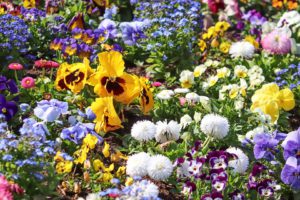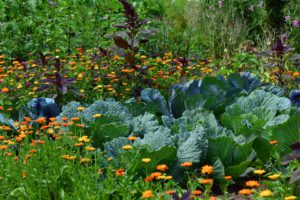Flowering Plants that Help each Other

The use of flowering plants in our gardens and landscapes can give that WOW, it’s so amazing how plants that produce flowers give not only a colorful tropical look but an appearance of a garden oasis that is so peaceful and inviting.
I remembered a few years ago working on a garden project which really needed lots of colors, this area was a high-traffic area. The contractors who did the job installed lots of plants where only a few gave colors but the majority of those plants did not produce flowers.
This area was an eyesore and really needed some sprucing up so both my team and I were given the responsibility to give this area a makeover and what a makeover, this garden area was totally transformed into a work of art very pleasing to the eyes.
This shows the importance of adding flowering plants, but there is a method that can be used that will really benefit your garden not only by adding flowers for color coordination but plants that will give you the best of both worlds which is known as companion Planting.
Plants Helping Plants
What is companion planting and how can we use this method in helping our garden plants?
Companion planting is a group of different plant species that will benefit each other.
The Benefits of Companion Planting
- Supports biological control ( the control of garden insect pests )
- Improving soil fertility
- Aesthetics
- Contributes with pollination
- Attracts beneficial insects
- Acts as a shelter
- Keeps weeds down
Companion Planting With Flowers
Supports Biological Control
1. There are many plants that attract beneficial insects, these beneficial insects will feed on garden insect pests ( the bad bugs ).
Improves Garden Soil Fertility
2. This process is done by certain species of plants such as members of the legume family which draws nitrogen from the atmosphere and adds it to the ground around plants.
Aesthetics
3. The different shapes and sizes along with various colors will enhance the overall appearance of your garden and landscape areas.
Contributes with Pollination
4. Certain garden plants attract pollinators such as bees.
Attracts Beneficial Insects
5. As discussed earlier there are certain plant species that will attract beneficial insects.
Acts as a Shelter
6. Because their height and size will protect or shade the smaller plants which may be vulnerable to the scorching heat.
Keeps Weeds Down
7. There are many garden plants that are used to suppress weeds by blocking the sunlight from reaching them which they need.
Given this list, it is quite clear that companion planting is a garden method that will benefit both us and our garden plants which is a win-win.
Flowering Plants that Will Attract Beneficial Insects
1. Hibiscus are beautiful tropical plants that come in so many colors, besides its flower bloom, hibiscus attracts ladybugs a beneficial insect that feeds on mealybugs. Other plants that attract ladybugs are tansy, butterfly weeds, dandelion, and basket of gold.
2. Marigolds in your garden are like having a gold mine, marigolds will not only attract beneficial insects but butterflies. The roots of marigolds are also known to be toxic and will work against root-knot nematodes. Root-knot nematodes are worm-like microscopic organisms that inhabit the soil causing much harm to plant life.
3. Coneflowers or the echinacea plant will not only attract butterflies but beneficial insects that will feed on garden insect pests.
4. The lacewings which are also beneficial feed on a host of garden insect pests including aphids some plant that attracts the lacewings are Tanys, prairie sunflower, cosmos, white sensation, and purple poppy mallow.
5. Including plants such as marigold, cosmos, yarrow, and angelica will attract the praying mantis along with other beneficial insects.
6. If you’re looking for pollinators such as bees then install plants such as Chrysanthemum, lavenders, zinnias, cosmos, asters, snapdragon foxglove, bee balm, goldenrod, black-eyed-Susan, Milkweed, pansy, phlox, salvia, sunflowers, berry plants, vegetables, and fruit trees will have your garden buzzing with activity.
Additional information
Soil Type
1. When grouping plants together ensure that they have the same soil requirements what you don’t want is to install garden plants together that have different soil requirements.
What you don’t want is to install and agave in a plant bed which does well in sandy soils with a plant like the peace lily which needs soil that retains moisture so know your soil type for your plants and install accordingly.
Watering Needs
2. Know your plants watering needs what you don’t want is to group garden plants together which has different water needs.
Grouping together a drought-tolerant plant-like agave and the peace lily which is a high-maintenance plant, spells disaster while one requires little water the other water requirements is much more which means one plant will suffer at the expense of the other so again it is knowing the watering needs of your plants and group them together so plants that don’t require much water will be grouped together in the same bed.
Soil PH
3. The soil ph plays an important part in a plant’s life, nutrient availability is dependent on the soil ph. It is, therefore, best to get a soil ph test done first to make the needed adjustment for your plants and also install plants that have similar ph requirements.
Fertilizers
4. Fertilizers are so important in the life of a plant, these nutrients are the building blocks that will keep your garden plants growing healthy and strong if you’re not using organics such as cow, chicken, or horse manure use made-made (synthetics) fertilizers make sure that you read and follow the manufacture’s label.
Properly Applying Fertilizers
5. When applying fertilizers apply at the soil or ground level and give plants the right amount of water to keep growing healthy.
Garden Insect Pests

6. Garden insect pests can cause serve damage to plant life, there are many methods of dealing with them, whether mechanically, biologically, or with the use of chemicals. Each method may depend on the severity of the infestation. That’s why it is good to do regular inspections of your garden plants identifying the garden pests and choosing which method works best for you. For more on garden insect pests control, refer to the category section of this website.
A Clean Garden
7. Having a garden that is free of debris is so important because an unkempt garden is so unattractive and will decrease a property’s value. Ensure that your garden beds are clean, all leaves that have fallen should be removed.
If you have a compost bin then leaves can go in this area but if there are diseased leaves or leaves which have insects then properly dispose of them.
Pruning
8. Pruning helps garden plants to become fuller with flower bloom, also pruning helps plants to maintain their natural form. All disease plant parts should be pruned and properly disposed of. Sterilize your pruner and other garden tools to avoid the spread of disease.
Deadheading
9. Deadheading is the removal of spent or faded flowers, the reason why deadheading is important for your flowering plants is to stop them from focusing their energy on seed setting but rather on flower production.
Disease Control
10. A big problem that affects many garden plants is plant disease, one of the main factors that encourage plant disease is overwatering, prolonged moisture, and using garden tools that are infected. For more on plant disease, signs to look for and their control refer to the category section of this website.
Weed Control
11. Weeds compete with garden plants for water, sunlight, and nutrients, therefore, it is best to keep your garden free of weeds. Weeds also harbor garden insect pests and encourage disease. These are other reasons to stay on top of weeds, for more on weed control refer to the category section of this website.
The final word
The final word on planting with flowering plants where they compliment each other is so neat, this method is being used on a wider scale by so many as they see the benefits of using garden plants that can help each other so if you’re interested in this gardening method then I urge you to go for it and join the many who are having much success with companion planting with flowers.
About the author
Norman loves being in the garden, both at home and for his job....
he is 'Natures Little helper' being outdoors, growing his vegetables and flowers from an early age.
Now having spent over 22 years in the profession he want to give some of his knowledge to others...
his vast array of hints and tips you will find scattered over this site will help you no end growing plants in your garden.
